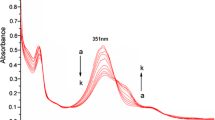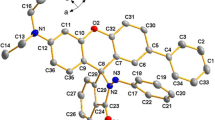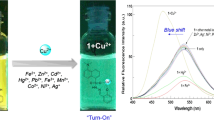Abstract
Fluorescent probes are intriguing material for ion detection. In this study, 4,4-difluoro-4-bora3a,4a-diaza-s-indacene (BODIPY) containing a dipicolylethylenediamine unit was developed as a colorimetric and fluorescence “turn-off” probe for Cu2+. The probe exhibited higher selectivity for Cu2+ than other common metal ions with a detection limit of 8.49 μM. With increasing Cu2+ concentration, the probe showed a red-shift in the absorption spectrum as well as fluorescence quenching, possibly due to the intramolecular charge transfer effect of the probe–Cu(II) complex. Furthermore, the probe was used for imaging Cu2+ in living cells based on confocal fluorescence imaging. The results show that the probe is an effective tool for detection copper ions.






Similar content being viewed by others
Data Availability
Data generated or analyzed during this study are included in this published article.
References
Gozzelino R, Arosio P (2016) Iron homeostasis in health and disease. Int J Mol Sci 17:130
Coleman JE (1992) Zinc proteins: enzymes, storage proteins, transcription factors, and replication proteins. Annu Rev Biochem 61:897–946
Daniel KG, Harbach RH, Guida WC, Dou QP (2004) Copper storage diseases: Menkes, Wilsons, and cancer. Front Biosci 9:2652–2662
Valentine JS, Hart PJ (2003) Misfolded CuZnSOD and amyotrophic lateral sclerosis. P Natl Acad Sci 100:3617–3622
Madsen E, Gitlin JD (2007) Copper and iron disorders of the brain. Annu Rev Neurosci 30:317–337
Kim B-E, Nevitt T, Thiele DJ (2008) Mechanisms for copper acquisition, distribution and regulation. Nat Chem Biol 4:176–185
Hung YH, Bush AI, Cherny RA (2010) Copper in the brain and Alzheimer’s disease. J Biol Inorg Chem 15:61–76
Millhauser GL (2004) Copper binding in the prion protein. Acc Chem Res 37:79–85
Lee JC, Gray HB, Winkler JR (2008) Copper (II) binding to α-synuclein, the Parkinson’s protein. J Am Chem Soc 130:6898–6899
Liu Y, Liang P, Guo L (2005) Nanometer titanium dioxide immobilized on silica gel as sorbent for preconcentration of metal ions prior to their determination by inductively coupled plasma atomic emission spectrometry. Talanta 68:25–30
Poursaberi T, Hajiagha-Babaei L, Yousefi M, Rouhani S, Shamsipur M, Kargar-Razi M, Moghimi A, Aghabozorg H, Ganjali MR (2001) The Synthesis of a New Thiophene-Derivative Schiff’s Base and Its Use in Preparation of Copper-Ion Selective Electrodes. Electroanal 13:1513–1517
Gonzales A, Firmino M, Nomura C, Rocha F, Oliveira P, Gaubeur I (2009) Peat as a natural solid-phase for copper preconcentration and determination in a multicommuted flow system coupled to flame atomic absorption spectrometry. Anal Chim Acta 636:198–204
Tian Y, Pepelnik R, Fanger H (1990) Multielement analysis of archaic Chinese bronze and antique coins by fast neutron activation analysis. J Radioanal Nucl Chem 139:43–53
Rao GPC, Seshaiah K, Rao YK, Wang M (2006) Solid phase extraction of Cd, Cu, and Ni from leafy vegetables and plant leaves using amberlite XAD-2 functionalized with 2-hydroxy-acetophenone-thiosemicarbazone (HAPTSC) and determination by inductively coupled plasma atomic emission spectroscopy. J Agric Food Chem 54:2868–2872
Jackson KW, Mahmood TM (1994) Atomic absorption, atomic emission, and flame emission spectrometry. Anal Chem 66:252–279
Pathirathna P, Yang Y, Forzley K, McElmurry SP, Hashemi P (2012) Fast-scan deposition-stripping voltammetry at carbon-fiber microelectrodes: real-time, subsecond, mercury free measurements of copper. Anal Chem 84:6298–6302
Edition F (2011) Guidelines for drinking-water quality. WHO Chronicle 38:104–108
Malavolta M (2018) Mocchegiani E. Trace elements and minerals in Health and Longevity: Springer
Sharma S, Ghosh KS (2021) Recent advances (2017–20) in the detection of copper ion by using fluorescence sensors working through transfer of photo-induced electron (PET), excited-state intramolecular proton (ESIPT) and Förster resonance energy (FRET). Spectrochim Acta A 254:119610
Boens N, Leen V, Dehaen W (2012) Fluorescent indicators based on BODIPY. Chem Soc Rev 41:1130–1172
Kowada T, Maeda H, Kikuchi K (2015) BODIPY-based probes for the fluorescence imaging of biomolecules in living cells. Chem Soc Rev 44:4953–4972
Lu H, Mack J, Yang Y, Shen Z (2014) Structural modification strategies for the rational design of red/NIR region BODIPYs. Chem Soc Rev 43:4778–4823
Yang J, Zhang R, Zhao Y, Tian J, Wang S, Gros CP, Xu H (2021) Red/NIR neutral BODIPY-based fluorescent probes for lighting up mitochondria. Spectrochim Acta A 248:119199
Sun Y, Yu X-a, Yang J, Gai L, Tian J, Sui X, Lu H (2021) NIR halogenated thieno [3, 2-b] thiophene fused BODIPYs with photodynamic therapy properties in HeLa cells. Spectrochim Acta A 246:119027
Shi H, Zhao F, Chen X, Yang S, Xing J, Chen H, Zhang R, Liu J (2019) Colorimetric and ratiometric sensors derivated from natural building blocks for fluoride ion detection. Tetrahedron Lett 60:151330
Liu Z, Jiang Z, Xu C, Chen B, Zhu G (2021) Fluorenyl-difluoroboron-β-diketonates with multi-stimuli fluorescent response behavior and their applications in a thermochromic logic gate device. Dyes Pigm 186:108990
Teknikel E, Unaleroglu C (2022) 2, 3, 5, 6-Tetrabromo-8-phenyl BODIPY as a fluorometric and colorimetric probe for amines. J Photochem Photobiol A 422:113549
Zhang X-F, Zhang Y, Xu B (2017) Enhance the fluorescence and singlet oxygen generation ability of BODIPY: Modification on the meso-phenyl unit with electron withdrawing groups. J Photochem Photobiol A 349:197–206
Wu Q, Wang S, Hao E, Jiao L (2021) Highly selective, colorimetric probes for cyanide ion based on β-formylBODIPY dyes by an unprecedented nucleophilic addition reaction. Spectrochim Acta A 247:119102
Kubheka G, Sanusi K, Mack J, Nyokong T (2018) Optical limiting properties of 3, 5-dipyrenylvinyleneBODIPY dyes at 532 nm. Spectrochim Acta A 191:357–364
Praikaew P, Roongcharoen T, Charoenpanich A, Kungwan N, Wanichacheva N (2020) Near-IR aza-BODIPY-based probe for the selective simultaneous detection of Cu2+ in aqueous buffer solutions and its application in biological samples. J Photochem Photobiol A 400:112641
Xia S, Shen J, Wang J, Wang H, Fang M, Zhou H, Tanasova M (2018) Ratiometric fluorescent and colorimetric BODIPY-based sensor for zinc ions in solution and living cells. Sens Actuators B 258:1279–1286
Wang J, Xie Y, Wang Z, Song Q (2014) A highly sensitive and selective naked-eye probe for detecting copper ion based on 2, 3-modified Bodipy derivatives. Sens Actuators B 194:149–155
Sun R, Wang L, Jiang C, Du Z, Chen S, Wu W (2020) A Highly Efficient BODIPY Based Turn-off Fluorescent Probe for Detecting Cu2+. J Fluoresc 30:883–890
More AB, Mula S, Thakare S, Chakraborty S, Ray AK, Sekar N, Chattopadhyay S (2017) An acac-BODIPY dye as a reversible “ON-OFF-ON” fluorescent sensor for Cu2+ and S2-ions based on displacement approach. J Lumin 190:476–484
Zhang J, Zhao B, Li C, Zhu X, Qiao R (2014) A BODIPY-based “turn-on” fluorescent and colorimetric sensor for selective detection of Cu2+ in aqueous media and its application in cell imaging. Sens Actuators B 196:117–122
Zeng L, Miller EW, Pralle A, Isacoff EY, Chang CJ (2006) A selective turn-on fluorescent sensor for imaging copper in living cells. J Am Chem Soc 128:10–11
Song Y, Tao J, Wang Y, Cai Z, Fang X, Wang S, Xu H (2021) A novel dual-responsive fluorescent probe for the detection of copper (II) and nickel (II) based on BODIPY derivatives. Inorg Chim Acta 516:120099
Di L, Yang J, Tang W, Gai L, Zhou Z, Lu H (2020) Nonsymmetric Benzo[a] fused and Thiophene/Thieno [3, 2-b] thiophene [b] fused BODIPYs: Synthesis and Photophysical Properties. J Org Chem 86:601–608
Sun Y, Yuan H, Di L, Zhou Z, Gai L, Xiao X, He W, Lu H (2019) Non-symmetric thieno [3, 2-b] thiophene-fused BODIPYs: synthesis, spectroscopic properties and providing a functional strategy for NIR probes. Org Chem Front 6:3961–3968
Frisch MJ et al (2016) Gaussian 16 Rev. C.01. Wallingford, CT
Ogren PJ, Meetze A, Duer WC (2009) The limit of detection in generalized least-squares calibrations: an example using alprazolam liquid chromatography-tandem mass spectrometry data. J Anal Toxicol 33:129–142
Montville D, Voigtman E (2003) Statistical properties of limit of detection test statistics. Talanta 59:461–476
Funding
This work was supported by the National Natural Science Foundation of China (No. 21801057, 21871072). Theoretical calculations were performed at the Computational Center for Molecular Design of Organosilicon Compounds, Hangzhou Normal University.
Author information
Authors and Affiliations
Contributions
Shujun Ren: Methodology, Synthesis and resources. Linting Di: Conceptualization investigation, material preparation. Chang-an Ji: Conceptualization, investigation. Lizhi Gai: Review, supervision writing, writing original draft. Hua Lu: Review, supervision.
Corresponding authors
Ethics declarations
Ethical Approval
This article does not contain any studies with human or animal subjects.
Consent to Participate
Not applicable.
Consent for Publication
Not applicable.
Conflicts of Interest
The authors declare that they have no conflict of interest.
Additional information
Publisher's Note
Springer Nature remains neutral with regard to jurisdictional claims in published maps and institutional affiliations.
Supplementary Information
Below is the link to the electronic supplementary material.
Rights and permissions
About this article
Cite this article
Ren, S., Di, L., Ji, Ca. et al. A Colormetric and Fluorescence Probe for Highly Specific Cu2+ and its Application in Live Cell Imaging. J Fluoresc 32, 2015–2021 (2022). https://doi.org/10.1007/s10895-022-03002-4
Received:
Accepted:
Published:
Issue Date:
DOI: https://doi.org/10.1007/s10895-022-03002-4




